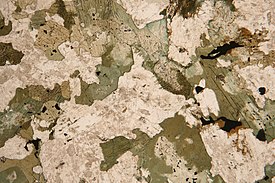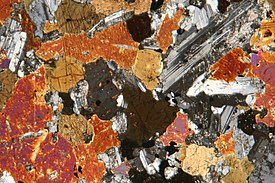Mafic
Mafic minerals, mafites (or dark minerals) are minerals that are highly rich in magnesium and iron. Accordingly, the root word maf- is composed of ma for magnesium and f for ferrum (iron). Mafic minerals occur predominantly in magmatic rocks (magmatites) and their metamorphic equivalents.
The mafic minerals include the rock-forming mica, amphibole, pyroxene, olivine, opaque minerals (ore minerals), epidote, garnets, melilite and the accessory zircon, apatite, orthite, (allanite), titanite. In addition, there are the rare, also magmatically formed carbonate minerals in the carbonatites and individual foidites.
However, the colouring alone is not a sufficient identification feature, because depending on the proportion of magnesium and iron, different colourings result. The more iron is contained in the minerals, the darker, and the more magnesium, the lighter to translucency they become. Because they contain relatively little quartz (SiO2) (the anhydride of silica), they are also classified as basic minerals. Although the feldspar representatives (foids) only form in the case of a severe SiO2 deficiency, they are not counted among the mafic minerals, but among the felsic minerals.
In magmatic rocks, mafic minerals always occur primarily, i.e. they have crystallized out of a rock melt (magma), and not, as is possible with metamorphic rocks, secondarily in the course of a metamorphosis, or, as with sedimentary rocks, as a result of erosion, transport and deposition into the rock. Because mafic minerals are metastable at the Earth's surface and weather chemically relatively quickly over geologic time, they are very rare in unmetamorphosed sedimentary rocks on Earth. Magmatic rocks with high proportions of mafic minerals (high colour number) are called mafic rocks or basic rocks and magmatic rocks with very high proportions of mafic minerals (over 90 %) are called ultramafic rocks or ultrabasic rocks.
Microscopic image of the thin section of a diorite. The grains of non-opaque mafic minerals typically appear greenish (here predominantly hornblende) or brownish, the felsic minerals typically appear colourless to "dirty-cloudy" (width of the image section: approx. 2 mm).
Microscopic image of a thin section of the same rock with crossed polarizers. Many mafic minerals are characterized by variegated interference colours and can thus be easily distinguished from the often greyish and whitish appearing felsic minerals (here, clearly recognizable on the basis of the twin lamellae, predominantly plagioclase) (width of the image section: approx. 1.5 mm).
Questions and Answers
Q: What does the term "mafic" refer to?
A: Mafic is an adjective describing a silicate mineral or igneous rock which is rich in magnesium and iron.
Q: How is the term "mafic" derived?
A: The term "mafic" is a portmanteau made from "magnesium" and "ferric".
Q: What are some features of mafic minerals?
A: Mafic minerals are usually dark in color and have a specific gravity greater than 3.
Q: What are some common rock-forming mafic minerals?
A: Common rock-forming mafic minerals include olivine, pyroxene, amphibole, biotite and other micas, augite and the calcium-rich plagioclase feldspars.
Q: What are some common mafic rocks?
A: Common mafic rocks include basalt and gabbro.
Q: What distinguishes mafic rocks from felsic rocks?
A: In terms of chemistry, mafic rocks are on the other side of the rock spectrum from the so-called felsic rocks.
Q: What is the difference between mafic and felsic lava in terms of viscosity and explosiveness?
A: Mafic lava, before cooling, has a lower viscosity than felsic lava due to its lower silica content. Water and other volatiles can more easily and gradually escape from mafic lava, so eruptions of volcanoes made of mafic lavas are less explosively violent than felsic lava eruptions.
Search within the encyclopedia

